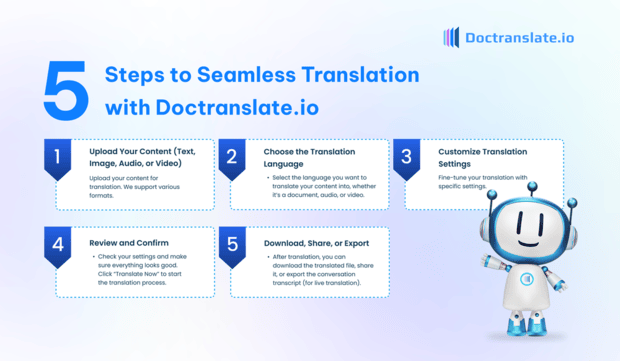Introduction
In today’s interconnected world, translating blog posts is crucial for reaching a wider audience. By breaking down language barriers, you can share your ideas and information globally.
Translating from Dutch to English opens your content to millions of readers. This expansion can significantly increase your blog’s impact and readership.
Doctranslate.io offers a powerful and user-friendly solution for translating blog posts. It ensures your message is accurately conveyed in English, maintaining the original tone and style.
This guide will show you how to easily translate your Dutch blog posts to English using Doctranslate.io. Achieve accurate and efficient translations with just a few simple steps.
Step-by-Step Guide: Translating Blog Posts from Dutch to English with Doctranslate.io
Step 1: Upload Your Content
Begin by uploading your Dutch blog post to Doctranslate.io. You can easily upload files in various document formats, such as DOCX or PDF.
Translate Document feature supports a wide range of file types. Simply select your document and upload it to the platform to start the translation process.
Ensure your blog post file is ready on your device. Doctranslate.io will handle the conversion and preparation for translation automatically after uploading.
Start by clicking on the ‘Translate Document’ option. Then, browse and select your Dutch blog post file from your computer to upload it to Doctranslate.io.
Step 2: Choose the Translation Language
After uploading your blog post, specify the target language for translation. In this case, you will select English as the desired output language.
Doctranslate.io supports a multitude of languages. Choose English from the language options to ensure your blog post is translated from Dutch to English.
Selecting the correct target language is crucial for accurate translation. Double-check that you have chosen English before proceeding to the next step.
The intuitive interface of Doctranslate.io makes language selection straightforward. Simply find and select ‘English’ from the dropdown menu.
Step 3: Customize Your Translation Settings
Doctranslate.io allows you to customize translation settings for optimal results. Tailor the translation to fit your specific needs.
For document translation, you can adjust settings like tone and domain. These customizations help refine the translation and ensure it matches your blog’s style.
Consider using the ‘My Dictionary’ feature to further enhance accuracy. This allows you to add specific terms and phrases for precise translation. You can access the customization options via Customize Document Translation.
Explore options such as bilingual output if needed. Although not always necessary for blog translation, it’s a useful feature available on Doctranslate.io.
Step 4: Review and Confirm
Before initiating the translation, review all your settings. Ensure that the input language is Dutch and the output language is set to English.
Double-check any customized settings you have applied, such as tone or domain preferences. Verify that these settings align with your desired translation outcome.
Once you are satisfied with your settings, proceed by clicking the ‘Translate Now’ button. This will prompt Doctranslate.io to begin the translation process.
Confirming your settings ensures accuracy and efficiency in the translation. Take a moment to review everything before starting the translation process on Doctranslate.io.
Step 5: Download, Share, or Export
After Doctranslate.io completes the translation, your English blog post is ready. You can now download the translated document directly to your device.
The platform provides options to download the file in its original format or other compatible formats. Choose the option that best suits your needs for using the translated blog post.
Share your translated blog post easily with your global audience. Upload it to your blog platform or share it via email or social media channels.
With Doctranslate.io, accessing and using your translated blog post is simple and efficient. Download and start sharing your content in English immediately.

Conclusion
Translating blog post from Dutch to English is now straightforward with Doctranslate.io. By following these five steps, you can efficiently convert your Dutch content into English.
Doctranslate.io ensures accurate and high-quality translations, helping you reach a broader, English-speaking audience. Expand your blog’s global reach and impact today.
Experience the ease and power of Doctranslate.io for all your translation needs. From documents to other content types, Doctranslate.io simplifies the process.
Don’t let language barriers limit your blog’s potential. Visit Doctranslate.io now to start translating your blog posts and connect with a global readership!


Leave a Reply